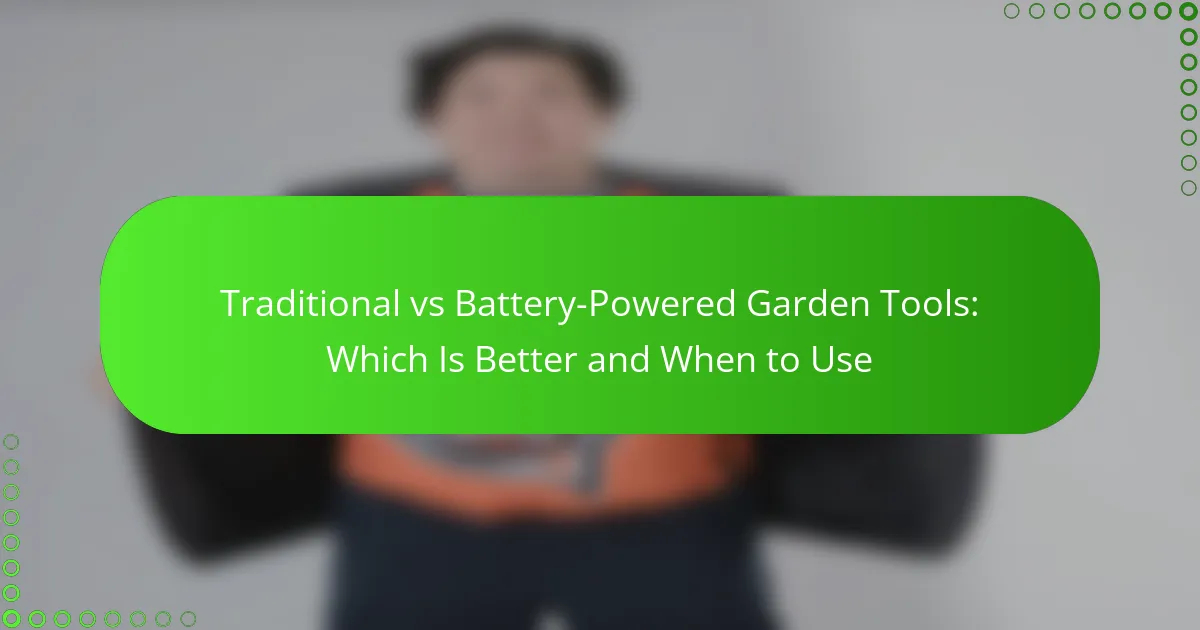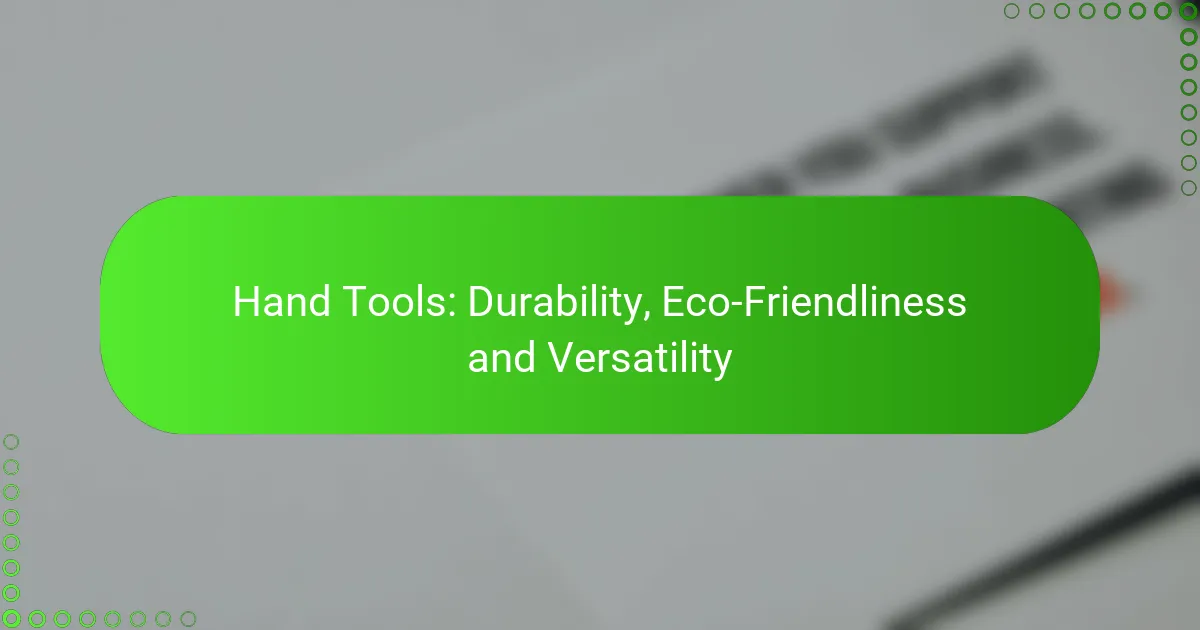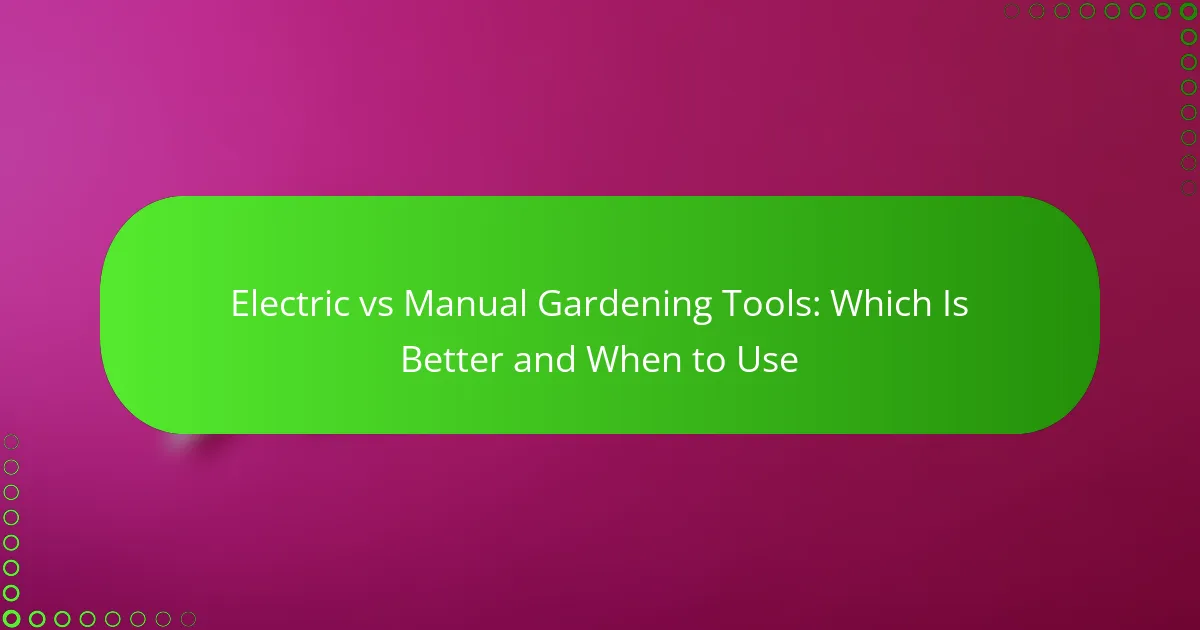When choosing between traditional and battery-powered garden tools, it’s essential to consider the specific gardening tasks and your personal preferences. Traditional tools are known for their durability and precision, making them ideal for detailed work, while battery-powered options offer convenience and mobility for lighter tasks. Understanding the strengths of each type can help you select the right tools for your gardening needs.

Which garden tools are best for South Africa?
In South Africa, the best garden tools depend on the specific gardening tasks and personal preferences. Traditional tools offer durability and reliability, while battery-powered tools provide convenience and ease of use.
Traditional tools for durability
Traditional garden tools, such as spades, hoes, and rakes, are often made from sturdy materials like steel and wood, making them highly durable. These tools are ideal for heavy-duty tasks, such as digging in tough soil or clearing debris, where strength is essential.
When using traditional tools, consider their maintenance. Regular cleaning and proper storage can extend their lifespan significantly. For example, keep metal parts rust-free by applying a light oil after use.
Battery-powered tools for convenience
Battery-powered garden tools, including hedge trimmers and lawnmowers, are designed for ease of use and mobility. They eliminate the hassle of cords and fuel, allowing for quick and efficient gardening without the need for extensive setup.
However, it’s important to consider battery life and charging times when choosing these tools. Many battery-powered devices can operate for about 30 to 60 minutes on a full charge, so having a spare battery can be beneficial for larger tasks. Always check the voltage and compatibility with your existing tools to ensure optimal performance.

When should I use traditional garden tools?
Traditional garden tools are best used for tasks that require manual effort and precision. They excel in situations where control and technique are essential, making them ideal for various gardening activities.
Heavy-duty tasks
For heavy-duty tasks such as digging, tilling, or breaking up compacted soil, traditional tools like shovels and hoes are often more effective. These tools provide the necessary leverage and strength to handle tough materials, especially in larger gardens or when working with dense earth.
When using traditional tools for heavy tasks, ensure you have the right tool for the job. For example, a spade is better suited for cutting through roots, while a garden fork is ideal for aerating soil. Consider your physical strength and stamina, as these tasks can be labor-intensive.
Precision work
Precision work, such as planting seeds or pruning plants, benefits greatly from traditional garden tools. Hand tools like trowels and pruners allow for greater control and accuracy, which is essential when dealing with delicate plants or small spaces.
When performing precision tasks, focus on using sharp, well-maintained tools to ensure clean cuts and minimal damage to plants. Take your time to avoid overworking the soil or harming nearby plants, as this can lead to poor growth or disease. For best results, use these tools in well-defined areas where you can easily manage your movements.
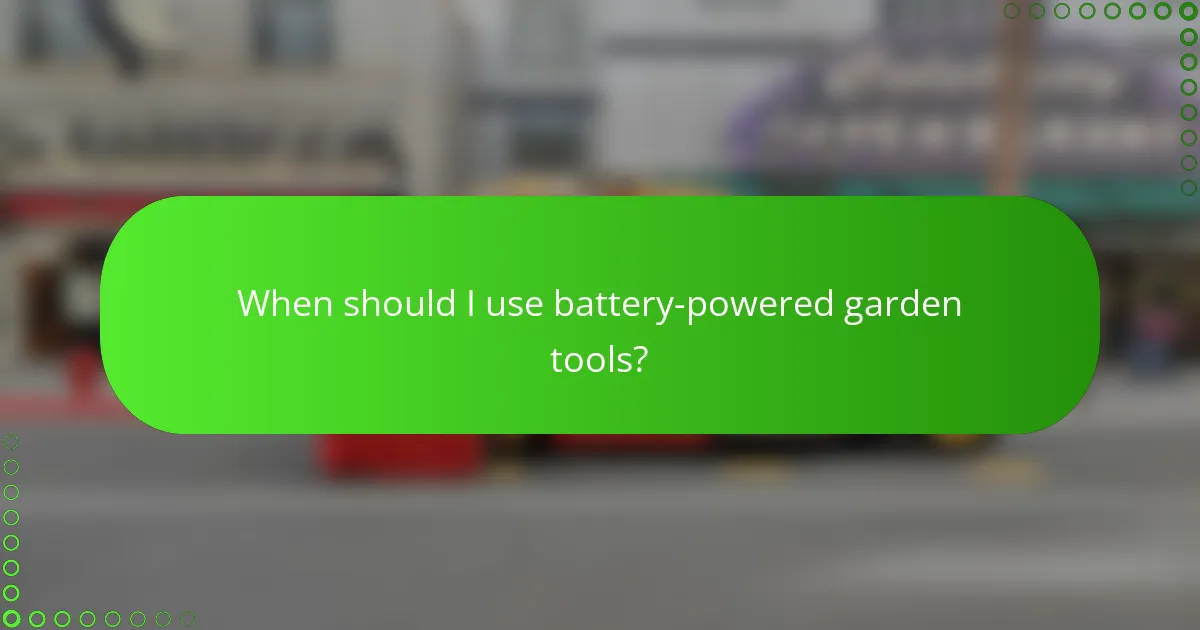
When should I use battery-powered garden tools?
Battery-powered garden tools are ideal for tasks that require mobility and convenience without the hassle of cords. They are particularly useful for light-duty jobs and projects that need to be completed quickly.
Lightweight tasks
For lightweight tasks such as trimming hedges, mowing small lawns, or edging flower beds, battery-powered tools excel due to their portability and ease of use. These tools typically weigh less than traditional gas-powered options, making them easier to handle for extended periods.
Examples of lightweight battery-powered tools include cordless hedge trimmers and small lawn mowers. They are perfect for homeowners who maintain modest garden spaces and prefer a quieter, more eco-friendly option.
Time-sensitive projects
When you have time-sensitive projects, such as preparing your garden for an upcoming event or quickly clearing debris after a storm, battery-powered tools can save you valuable time. They often start instantly, eliminating the wait associated with gas-powered tools.
Consider using battery-powered blowers or trimmers for quick clean-up tasks. Their rapid charging capabilities mean you can often complete your work without long interruptions, making them a practical choice for urgent gardening needs.

What are the pros and cons of traditional garden tools?
Traditional garden tools offer durability and simplicity, making them a reliable choice for many gardeners. However, they require more physical effort and can be less convenient compared to battery-powered options.
Long lifespan
Traditional garden tools are typically made from robust materials like steel and wood, which contribute to their long lifespan. With proper care, these tools can last for decades, making them a worthwhile investment for serious gardeners.
In contrast, battery-powered tools often have a limited lifespan due to battery degradation, which usually occurs after a few years of regular use. This difference can affect long-term costs and tool replacement frequency.
Lower maintenance costs
Maintenance costs for traditional tools are generally lower since they do not require batteries or complex electronic components. Regular cleaning, sharpening, and occasional repairs are usually sufficient to keep them in good working order.
Battery-powered tools, on the other hand, may incur higher maintenance costs due to battery replacements and potential repairs of electronic parts. Gardeners should consider these ongoing expenses when choosing their tools.
Physical effort required
Using traditional garden tools often demands more physical effort, which can be a downside for some users. Tasks like digging or pruning may require significant strength and stamina, making them less suitable for individuals with physical limitations.
However, this physical engagement can be beneficial for fitness and provides a more hands-on gardening experience. Gardeners should weigh the benefits of exercise against the potential strain when deciding on tool types.
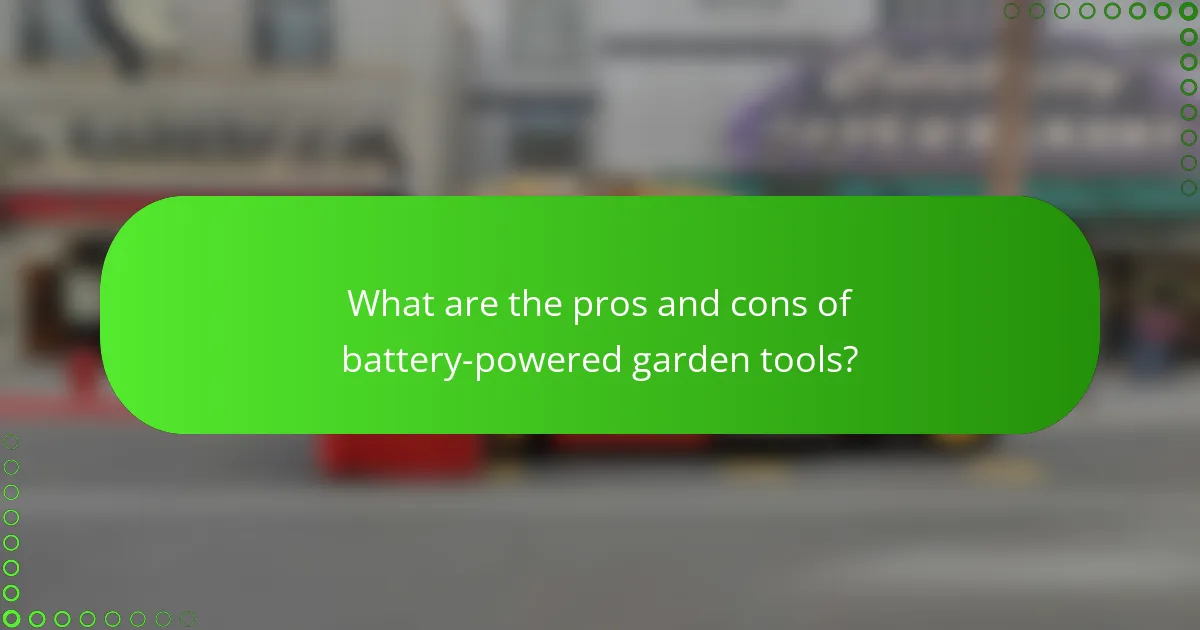
What are the pros and cons of battery-powered garden tools?
Battery-powered garden tools offer convenience and portability, making them popular among gardeners. However, they also come with limitations such as battery life and cost that should be carefully considered.
Ease of use
Battery-powered garden tools are generally easier to operate than traditional gas-powered models. They are lighter, require less maintenance, and start with the push of a button, eliminating the hassle of pull cords and fuel mixing.
This ease of use makes them ideal for casual gardeners or those with limited strength, as they reduce physical strain during tasks like trimming or mowing. Additionally, many models are designed with ergonomic features, enhancing comfort during extended use.
Limited battery life
One significant drawback of battery-powered tools is their limited battery life, which can vary widely based on the tool type and usage. Most batteries last anywhere from 30 minutes to a few hours, depending on the intensity of the task.
To mitigate this issue, consider investing in extra batteries or a fast charger. Planning your gardening tasks around battery life can also help ensure you complete your work without interruptions.
Higher initial cost
Battery-powered garden tools typically have a higher initial cost compared to their traditional counterparts. While prices can vary, you might find that quality battery tools start at a few hundred dollars, whereas gas tools can be more affordable.
Despite the higher upfront investment, battery tools can save money over time due to lower maintenance costs and no fuel expenses. Weighing the initial cost against long-term savings is essential when deciding which tools to purchase.
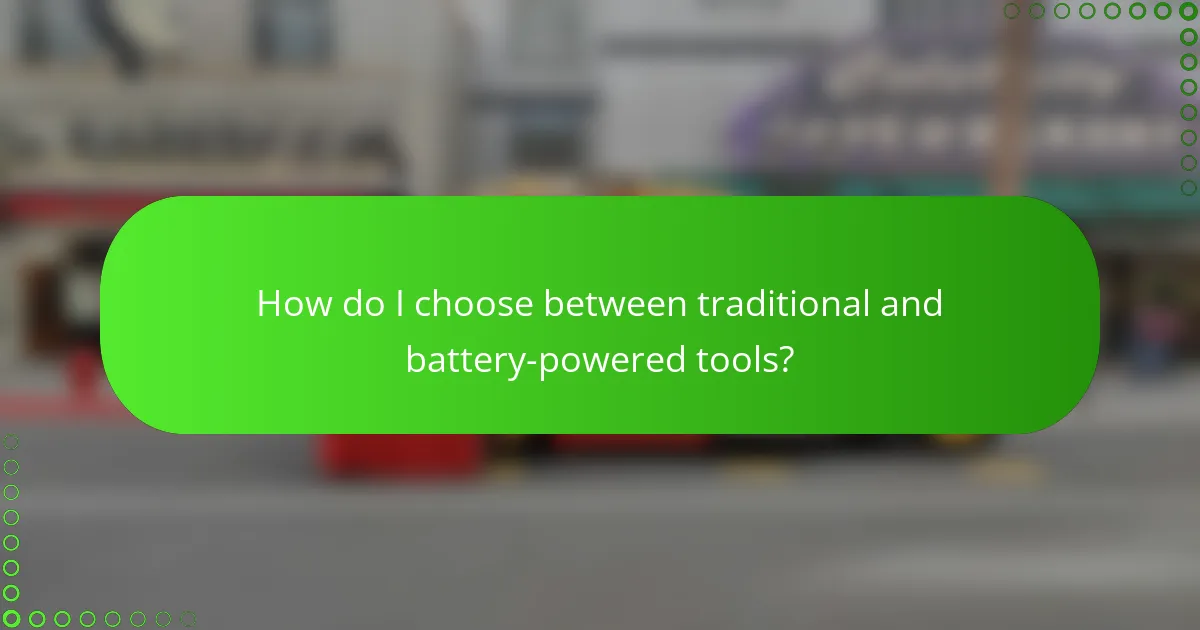
How do I choose between traditional and battery-powered tools?
Choosing between traditional and battery-powered garden tools depends on your specific gardening needs, preferences, and circumstances. Consider factors such as garden size, budget, and the type of tasks you frequently perform to make an informed decision.
Assessing garden size
The size of your garden significantly influences the choice between traditional and battery-powered tools. For small to medium-sized gardens, battery-powered tools can offer convenience and ease of use, allowing for quick maintenance without the hassle of cords or fuel. In larger gardens, traditional tools may be more reliable for extensive tasks, as they often have longer operational times and can handle heavier workloads.
Additionally, consider the layout of your garden. If your space has many obstacles or tight corners, battery-powered tools can provide the maneuverability needed to navigate these areas effectively. However, for vast open spaces, traditional tools might be more efficient due to their durability and power.
Evaluating budget
Your budget plays a crucial role in deciding between traditional and battery-powered tools. Traditional tools generally have a lower initial cost, making them accessible for those on a tight budget. However, keep in mind that they may require ongoing expenses for maintenance, fuel, or replacement parts.
Battery-powered tools often come with a higher upfront price, but they can save money in the long run due to lower maintenance costs and no need for fuel. When evaluating your budget, consider not only the purchase price but also the total cost of ownership over time, including battery replacements and charging equipment.

What are the best brands for traditional garden tools?
Some of the best brands for traditional garden tools include Fiskars, Felco, and Corona. These brands are known for their durability, ergonomic designs, and effectiveness in various gardening tasks.
Fiskars
Fiskars is renowned for its high-quality traditional garden tools, particularly its pruners, shears, and hoes. Their products are designed with ergonomic handles that reduce strain and improve comfort during extended use.
When choosing Fiskars tools, consider their innovative features like the patented blade technology that enhances cutting efficiency. Their tools often come with a lifetime warranty, reflecting their commitment to quality.
For best results, select Fiskars tools based on the specific gardening tasks you plan to undertake. For example, their bypass pruners are ideal for trimming live branches, while their anvil pruners are better suited for dead wood. Always check for the right tool for your needs to maximize performance and longevity.






